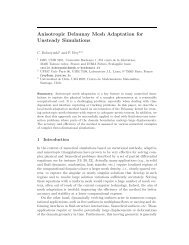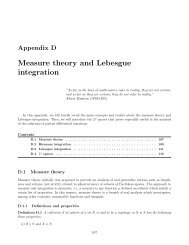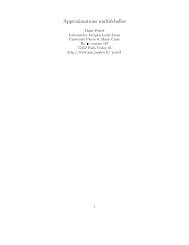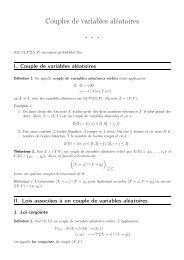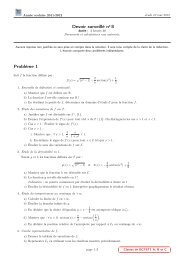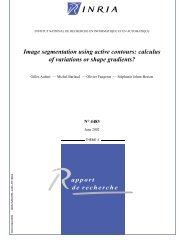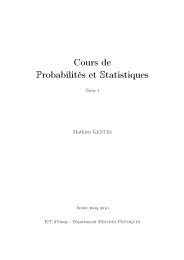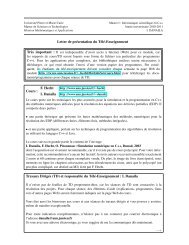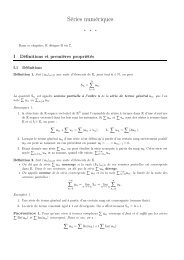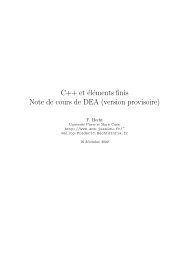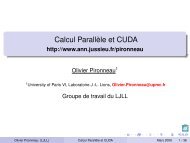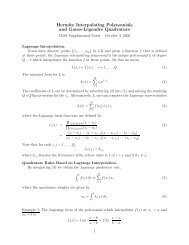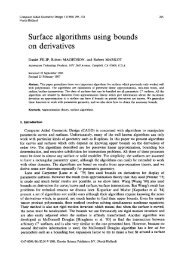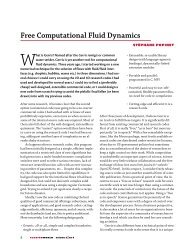pdf file
pdf file
pdf file
You also want an ePaper? Increase the reach of your titles
YUMPU automatically turns print PDFs into web optimized ePapers that Google loves.
BOGOLIUBOV SPECTRUM OF INTERACTING BOSE GASES 39<br />
Assumption (A3’) implies that TrΓ >M<br />
N<br />
Therefore,<br />
liminf<br />
N→∞ (Fβ(N)−NeH) ≥ liminf<br />
N→∞<br />
→ 0 and TrΓ≤M<br />
N<br />
→ 1 as N → ∞.<br />
�<br />
−β −1 logTre −β(1−CN−1/5 )H �<br />
= −β −1 logTre −βH .<br />
Here in the later equality we have employed the Dominated Convergence<br />
Theorem using Tre −β0H < ∞ for β0 < β in (A4).<br />
Step 2. Convergence of Gibbs states. From the above proof, we have<br />
�<br />
lim Tr[H<br />
N→∞<br />
� ΓN]−β −1 S( � �<br />
ΓN) = Tr[HΓ]−β −1 S(Γ)<br />
where<br />
�ΓN := fMΓNfM<br />
Tr[fMΓNfM] with M = N3/5 .<br />
We have proved that TrF+ [UNe −β(HN−NeH) U ∗ N ] → TrF+ e−βH as N → ∞,<br />
and we will now show that ΓN → Γ in the Hilbert-Schmidt norm. It is<br />
well known that a sequence of non-negative operators AN with Tr(AN) = 1,<br />
which converges weakly-∗ to an operator A, converges in the trace norm if<br />
and only if Tr(A) = 1 (see, e.g., [17], [48, Cor. 1] and [53, Add. H]). Using<br />
this fact, we will get the result. Moreover, by using Tr[( � ΓN −ΓN) 2 ] → 0 due<br />
to the condensation (A3’), it remains to show that Tr[( � ΓN −Γ) 2 ] → 0. The<br />
latter convergence follows from the equality<br />
Tr[H � ΓN]−β −1 S( � ΓN)− � Tr[HΓ]−β −1 S(Γ) � = β −1 Tr<br />
�<br />
ΓN(log � �<br />
ΓN −logΓ)<br />
and the following entropy estimate, which is inspired from [27, Theorem 1].<br />
The proof of Theorem 3 is finished. �<br />
Lemma 26 (Relative entropy inequality). If A and B are two trace class<br />
operators on a Hilbert space and 0 ≤ A ≤ 1, 0 ≤ B ≤ 1−ε for some ε > 0,<br />
then there exists Cε > 0 such that<br />
Tr[A(logA−logB)] ≥ CεTr[(A−B) 2 ]+Tr(A−B).<br />
Proof. A straightforward computation shows that for all x,y ∈ [0,1],<br />
x(logx−logy)−(x−y) ≥ g(y)(x−y) 2 with g(y) :=<br />
y −1−logy<br />
(y −1) 2 .<br />
Since the function y ↦→ g(y) is decreasing, we have g(y) ≥ g(1−ε) > 0 for<br />
all y ∈ [0,1−ε]. Therefore, By Klein’s inequality [62, p. 330], one has<br />
Tr[A(logA−logB)] ≥ g(1−ε)Tr[(A−B) 2 ]+Tr(A−B).<br />
The proof of Lemma 26 is finished. �



